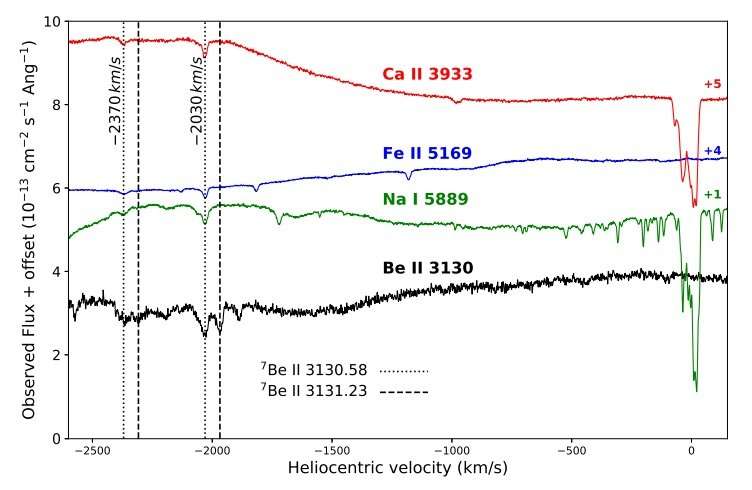February 26, 2018 report
Researchers detect beryllium in the fast nova ASASSN-16kt

An international team of researchers led by Luca Izzo of the Institute of Astrophysics of Andalusia, Spain, has conducted high-resolution spectroscopic observations of the fast nova ASASSN-16kt. The study, which resulted in detection of beryllium in this nova, appeared February 16 on arXiv.org.
ASASSN-16kt, also known as V407 Lup, was a fast oxygen-neon (ONe) nova some 33,000 light years away, detected by the All-Sky Automated Survey for SuperNovae (ASAS-SN) as a bright source on September 24, 2016. Two days later, it reached a maximum magnitude of 6.3 (in V-band) and started to decay rapidly.
Izzo's team commenced observational campaign of ASASSN-16kt shortly after its discovery. For their observations they employed the UVES and X-Shooter spectrographs at the ESO Very Large Telescope (VLT) in Chile, as well as the PUC High Echelle Resolution Optical Spectrograph (PUCHEROS) mounted on the ESO 0.5 m telescope located at the Observatory of Pontificia Universidad Catolica (OUC) in Chile.
These observations allowed the astronomers to reveal the existence of beryllium (Be) in ASASSN-16kt, among other elements.
"We present high-resolution spectroscopic observations of the fast nova ASASSN-16kt (V407 Lup). A close inspection of spectra obtained at early stages has revealed the presence of low-ionization lines, and among the others we have identified the presence of the ionized 7Be doublet in a region relatively free from possible contaminants," the researchers wrote in the paper.
The authors calculated that ASASSN-16kt has produced between 5.9 and 7.7-billionths of a solar mass of 7Be. Furthermore, they spotted bright neon (Ne) lines, what may indicate that the nova progenitor is a massive (about 1.2 solar masses) oxygen-neon white dwarf.
During advanced phases of red giant stars, the reaction of two isotopes of helium (He) - 3He with 4He can give rise to the 7Be isotope, which decays only through electron capture into lithium (Li) after a half-time decay of about 53 days. Thus, the finding of beryllium could be important to the understanding of novae in general. According to the study, the detection of 7Be, which decays completely into 7Li through electron capture in the early spectra of ASASSN-16kt, further confirms that novae represent the main Li-factories in our Milky Way galaxy.
"These findings imply that classical novae produced a huge quantity of Li, more than the value of 150 solar masses of Li estimated to be in the Milky Way," the paper reads.
However, the researcher emphasized that still more studies are required to fully understand the role of novae in lithium production. They added that future studies should focus on more precise characterization of beryllium and lithium mass produced during a nova outburst as a function of the progenitor white dwarf mass.
"Additional detections of 7Be II and/or 7Li combined with a detailed study of the ejecta properties, like its degree of asphericity, are needed to quantify the nova Galactic yield, and then to infer the presence of mechanisms acting during the TNR [thermo-nuclear runaway], or in the nova ejecta, that can deplete freshly-formed Li, and finally explain the over-abundances of Li observed in young stellar populations," the scientists concluded.
More information: Beryllium detection in the very fast nova ASASSN-16kt (V407 Lupi). arxiv.org/pdf/1802.05896.pdf
© 2018 Phys.org




















